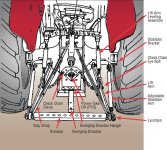msb1766
Platinum Member
I have been using a rear blade on my asphalt driveway for over 10 years with problems or damage, the only thing I did was grind the corners of the blade round,
so when the blade is angled it does not have a sharp corner to dig into the asphalt.
so when the blade is angled it does not have a sharp corner to dig into the asphalt.
